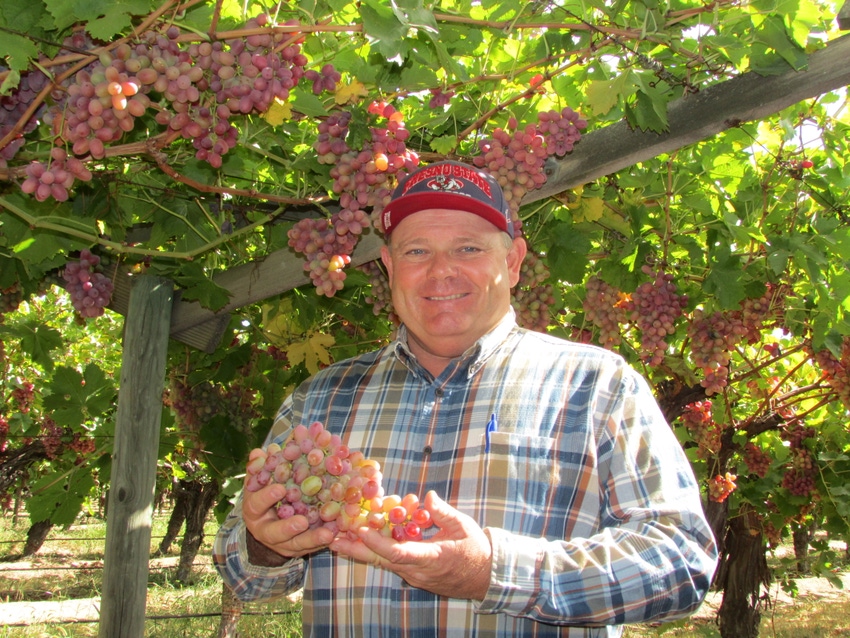
Most table grape varieties on the California State University, Fresno (Fresno State) farm produced well this year, except for the Princess and Thompson seedless varieties.These two varieties struggled with an excessive powdery mildew outbreak in the late spring during berry development when hot temperatures accelerated fungus growth and reduced overall berry size and yield.
October 17, 2014

The farm at California State University, Fresno (CSUF) has 40 acres of table grape vines from pale green in color to dark purple. Fresno State produces enough fresh market grapes during the season to satisfy consumer needs at the Gibson Farm Market located in Fresno, with enough left over to sell to several upscale grocery stores.
Mark Salwasser is the interim farm manager of the Fresno State farm and employed by CSUF’s Jordan College of Agricultural Sciences and Technology. He oversees vine-to-table production practices which use the best available practices in the table grape industry.
He says most varieties grown on the farm produced well this year, except for the Princess and Thompson seedless varieties. These two varieties struggled with an excessive powdery mildew outbreak in the late spring during berry development when hot temperatures accelerated fungus growth and reduced overall berry size and yield.
Typically, Fresno State’s Princess and Thompson yields are in the 900 box to 1,000 box range per acre. With the larger powdery mildew outbreak, yields dropped about 20 percent to 700-800 boxes per acre.
Meanwhile, Salwasser says all red grapes and later-season green varieties, including Flame seedless, Sweet Scarlet, Scarlet Royal, Ruby seedless, and Autumn King, produced a good crop yield.
In late September, the farm delayed the harvest of Crimson grapes so the cooler nights would bring additional color to the berries. The Crimson vines were loaded with prospects for good yields.
“The season started a little shaky, but the vines did much better closer to harvest,” Salwasser said.
Varietal diversification
Having numerous varieties of table grapes on the campus farm, he says, takes the sting out of having a few types which may under develop. It extends the season when fresh grapes are available to meet consumer demand over a longer period.
Currently, the farm’s cycle of harvesting grapes is three days a week which allows the stocking of university store shelves from late June through late October or early November.
Salwasser says consumers of the Fresno State fruit can look forward to newer varieties as the older vines yield less. For example, as the farm’s older Flame vines planted in the 1970’s begin to yield less, Salwasser wants to plant an early black variety to fill a missing void in the farm’s current variety mix.
Table grapes can be sold on the fresh market while many varieties can be processed into raisin.
“This allows the consumer who has a favorite table grape to also enjoy the same variety’s taste as a raisin as well,” Salwasser said.
Drought impact?
What impact has the tri-year drought had on the university-grown table grapes? Salwasser says the table grape vines have been mostly irrigated with well water for years and so far there has been little impact. Yet he added that long-term water concerns are under the watchful eye of Fresno State’s Center for Irrigation Technology.
Salwasser says the irrigation goal for the farm’s table grape vines has always been to replace the remaining flood-irrigated vines with drip irrigation. The drought increased the drip priority and now all CSUF table grape vines are drip irrigated.
Last year, due to the drought, the university applied less water to the vines after harvest. Then an early frost occurred last December. The combination of drought and the freeze damaged some vines which could be the reason for this year’s lower yields in some varieties.
Salwasser said, “I don’t think the vines were completely asleep before the early December frost arrived.”
Profits from the overall 960-acre Fresno State farm support the university’s Ag Foundation. The crop and livestock farm provides students with the on-site, hands-on farm to learn. Each semester, many class labs are held on the campus farm to study and research ongoing farm projects.
“Students have an opportunity to be involved in a broad spectrum of cultural activities on the farm and do some marketing as well,” said Salwasser.
CTGC marketing
The demand for table grapes continues to increase worldwide as consumers enjoy discovering tasty new varieties.
The Fresno-based California Table Grape Commission (CTGC), which Fresno State is a member, is a grower-funded state organization which is tasked with creating worldwide demand for this popular crop.
CTGC President Kathleen Nave says the commission has a very aggressive table grape promotional campaign in place through January to reach consumers domestically and abroad.
“Over the last 10 years, table grape volume has significantly increased,” Nave says.
“In 2012, the 100-million-box mark was crossed for the first time in history. In 2013, another record was set with the crop totaling 117.4 million boxes.”
Export volume also hit a new record with 48.6 million boxes shipped to export markets, including a 17-percent increase in table grapes shipped to Canada over the previous year.
The top export markets in volume included Canada at 11.9 million boxes, followed by China-Hong Kong at 7.9 million boxes and Mexico at 6.6 million boxes, respectively. The overall 48.6 million boxes sent to foreign destinations represented 41 percent of the total crop volume.
The other 59 percent is purchased by U.S. consumers.
Meanwhile, the CTGC recently awarded nine grower-funded scholarships to high school students from all grape-growing regions in California. Children of workers on commercial table grape farms received the scholarships.
The CTGC also recently funded a UC Cooperative Extension position in Tulare County.
You May Also Like



